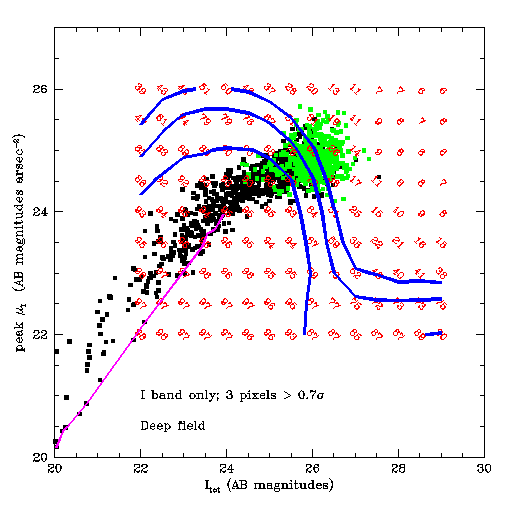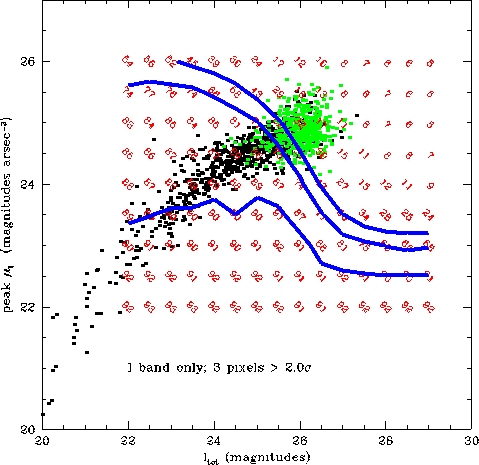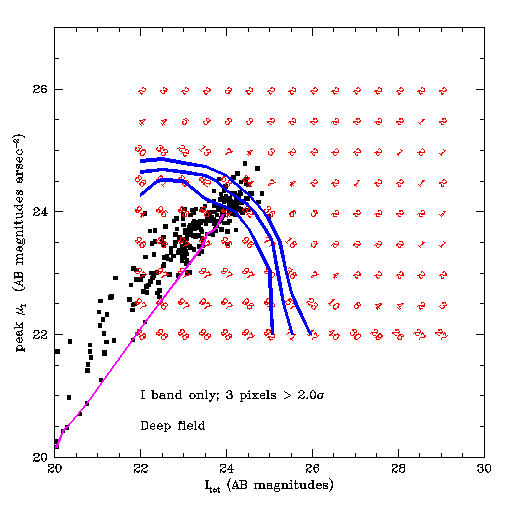
| The idea here is to test various galaxy detection methods to see which
produce the deepest, most reliable galaxy catalogs by adding artifical
galaxies to a subection of the VIRMOS images and attempting to
retreive them using various detection criteria. Both depth and reliability are important. In the extreme example, if uses as detection criteria: "an object must have greater than the sky background flux in one or more pixels" (an extremely liberal example) one will have an extremely deep catalog, but not a reliable one. If however one only uses: "galaxies which are detected in all four bands at the 20-sigma level", one will have a very reliable catalog, but one will not detect any Lyman break galaxies. To test the completeness limits of various detection schemes I have
written a program which adds several artifical galaxies to a 1024x1024
pixel sub-section of the VIRMOS images. One can then run SExtractor to
see which galaxies are detected. By varying the surface brightness and
magnitudes one can determine completeness as a function of these
The image subsection was provided by Henry McCracken. It is a portion of the 2 hr field. I have further reduced the image in size (to speed the iterations) to 1024x1024 subsection. The entire subsection is imaged to the same depth; that is to say, the weighting is uniform. This is obviously a much simplified version of what will be a much more complicated problem. The Fortran program (addgal.f) adds galaxies to the I-band image. The added galaxies are modeled with an exponential profile. Although a few galaxies will have other profiles (eg. ellipticals), this assumption will probably notoverly prejudice the results. Each time addgal is run, it adds 40 galaxies. Adding more generally results in artifically low completeness especially at bright magnitudes, as the galaxies start to overlap with each other and with the real galaxies. As it is, the maximum possible completeness is about 98%. All the galaxies are of the same brightness (I and mu_I). Two parameters control the brightness: the central surface brightness (in photons/pixel) and the exponential scale length (in pixels). The program then writes the image and the location of the added galaxies to disk. One can then run SExtractor to retrieve the artifical galaxies, with whichever detection criteria are desired. This process can be repeated several times for a range of magnitudes and surface brightnesses. The process needs to be run about 10 times at for (I, mu_I) pair. Currently, this process is controlled with PERL script: comp.pl The following graphs are plots of surface brightness in the I band vs. total I magnitude. The dots show detected galaxies. Therednumbers give the completeness levels (in percent) at different values of magnitude and surface brightness as determined from the simulations. The blue lines are contours at the 90, 70 and 50 completeness limits. |
| The detection criteria for the graph to the right are: 3 contiguous pixels in the I band image must be greater than 0.7 times the RMS of the background |  |
| This figure is the same as the previous with the
addition of some false positive results.
The original image was multiplyed by -1; the noise peaks became noise troughs and vice-versa. The same detection criteria was applied. Since there are no real negative galaxies, all the objects thus detected are spurious. The green points show these detections. |
 |
| The detection criteria for the graph to the right
are: 3 contiguous pixels in the I band image must be greater than 2.0 times
the RMS of the background. Not surprisingly, considerably fewer galaxies
are detected. However, note that the 90% completeness limit in surface
brightness is
at roughly the same level: ~24 mag/sq. arcsec. The same image reversion was applied. No false galaxies were detected in the negative image. |
 |
| This is obviouslly only a very rough stab at the problem. The next step is to modify addgal.f so that it adds galaxies to all four or the BVRI images so one can test the various coadded image methods: chi-squared, R+I, B+V+R+I, etc. This program is called addgal4.f and is under construction. |